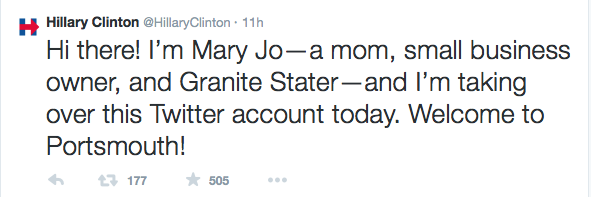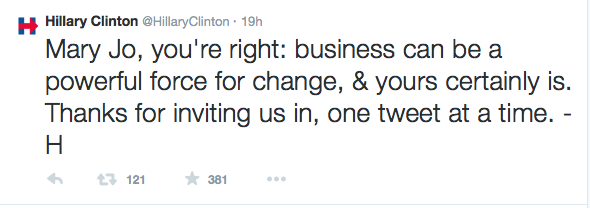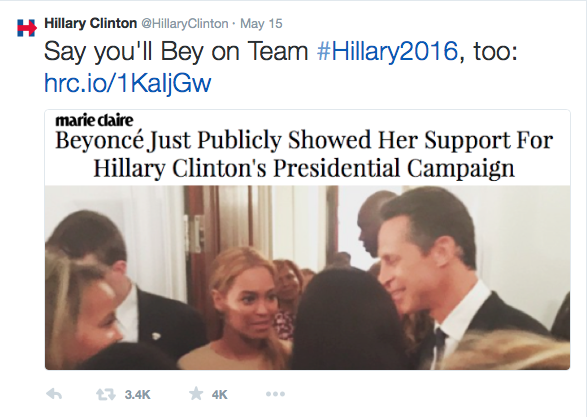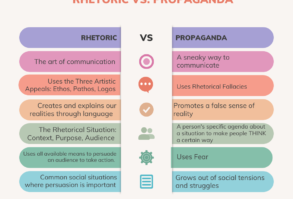I saw a tweet from former senior advisor Dan Pfeiffer that said:
This tweet reminded me of what I discussed in my dissertation about what Hillary’s 2008 Presidential Campaign lacked: Engagement.
In my dissertation I rhetorically analyzed Barack Obama, Hillary Clinton and John McCain’s campaign blogs. I collected 188 campaign blog posts from Hillary’s campaign website, 1, 491 blog posts from President Obama’s campaign website, and 128 blog posts for John Mcain’s campaign website. As you can see Hillary’s campaign lacked the depth and information that Obama’s campaign composed. Twitter was not the force it is in campaigns now. Believe it or not, 2008 was pre-hashtag craze. It wasn’t until the 2012 election where I first saw Twitter’s value in political campaigns.
Let me summarize my findings from the 2008 campaign.
President Obama’s campaign boasted his endorsements, which helped him gain ethos, credibility, between him and the electorate. As for Hillary Clinton her blog lacked such ethos examples. I found, ” While Obama’s blog highlights each endorsement in a stand-alone post, Clinton publishes her endorsements in her campaign blogs’ “Hubdates,” thus requiring blog readers to search for the endorsement announcements” (78).
President Obama allowed others to build his credibility. In fact,
His campaign identifies his weakness—his lack of experience—and counters that information by posting endorsement announcements: to show voters that credible politicians and organizations support Obama as the next president. (81)
Hillary Clinton wanted readers to be excited about being the first viable female presidential candidate. She also reminded her supporters that she’s behind in the polls:
Clinton urges her supporters to take responsibility for and ownership of her campaign. For example, in one post, Clinton says, “I need your help to win in Pennsylvania and the races beyond. Your commitment and investment are absolutely critical” (April 4,2008). Clinton pleads with readers to support her campaign so she can compete with Obama. Clinton often makes this type of plea, and each time, she mentions how much money Obama has raised and asks her supporters to continue to donate. (93)
The way the Obama campaign used pathos in his campaign blogs:
Obama creates a dialogical interaction with blog readers through his campaign blog and through that interaction, he motivates supporters to respond: to vote in primaries, to donate money, and to volunteer. Obama reminds people to make phone calls, to attend events, and to discuss Obama with their parents. Obama helps readers organize their thoughts about the presidential race and even influences his blog readers through rhetorical figures of speech and interactive visual rhetorical techniques such as “Make Calls” and “Donate” buttons. (101)
Hillary’s campaign lacked emotional depth to create a deep connection with the electorate. My advice then was for both John McCain and Hillary Clinton to engage their electorate.
Clinton and McCain frequently miss opportunities to connect emotionally with their audiences and thus they do not use their blogs—rhetorical tools—to emotionally connect. McCain should post more about his campaign needs and enlist his blog readers to help promote his campaign, and Clinton should balance the emotion that she expresses to do more than to urge supporters to donate. (101-102)
As for the best logical argument within the 2008 campaign blogs, Hillary again lacked in creating confidence in the electorate:
Overall, in his blogs Obama uses logical argumentative language more than Clinton and McCain. Obama’s motive for using logos figures of speech is to show readers his determination to win. This determination, Obama hopes, would inspire the grassroots efforts to keep fighting for his cause. The independent action created by such language by Obama is evident when Clinton admits that Obama has outspent and out- fundraised her campaign. Clinton’s campaign shows poor judgment in broadcasting Obama’s financial successes; however, overall, Obama’s supporters create more hype and more innovative techniques to keep Obama afloat, even with his fluctuating poll numbers. (148)
In “Discourse in the Novel,” in The Dialogical Imagination Bakhtin explains:
In political rhetoric […] discourse can support some candidacy, represent the personality of a candidate, present and defend his point of view, his verbal statements, or in other cases protest against some decree, law, order, announcement, occasion—that is, protest against the specific verbal utterances toward which it is dialogically aimed. (353)
Bakhtin’s explanation of political rhetoric is what Hillary NEEDS to do in 2016 through social media. The old-fashioned way of using television campaign ads, using news media to discuss important issues, and as effective as human interaction is to a campaign–social media can help candidates tap into audiences who don’t read the newspaper, who don’t attend rallies, who are not politically active, and who have no idea why Brian Williams is not broadcasting the news any longer.
In my opinion, Hillary alienated voters by actively pursuing the tactic that she was the first woman running for POTUS. The women in history blog posts that ran during the last of her campaign were written by influential women such as Maya Angelo, but again, she alienated a segment of her audience by not engaging a broader audience as did Obama.
What Hillary is doing right in 2016:
First she’s highlighting real people and as Dan Pfeiffer tweeted–this strategy is a smart way to engage supporters. In 2008, many Barack Obama supporters wrote blog posts that were highlighted on the main campaign blog. Now that Twitter is an asset to campaign with, the campaign blog can become an extension of the Twitterbites that campaigns post. Twitter can also help to instantly inform the electorate about campaigns. Hillary’s campaign team is smart to allow real people to post to help form the grassroots campaign by engaging the electorate, which then a campaign hopes will motivate more people to action to support Clinton’s campaign.

Hillary Clinton is also highlighting public endorsements. The more people, celebrities, politicians, etc, will help show that many people have confidence in Clinton’s ability to run the country.
Also highlighted on Clinton’s Twitter feed are volunteers showing how they are organizing and volunteering to help support Clinton’s campaign. In 2008, you did not see these people highlighted on her blog as much. These stories might have been elsewhere on Hillary Clinton’s campaign website, but the posts I collected did not.
Twitter has definitely upped engagement with the electorate. But, even when Mitt Romney used the platform in 2012, his campaign did not take the rhetorical advantage of Twitter. Now, a candidates’s Twitter stream can share video, photos, and links back to more information. Let’s not forget about live streaming speeches with Periscope and MeerKat.
Candidates will still be scrutinized through the news media and that’s part of the process. Hillary Clinton is already being scrutinized by avoiding the press. The more information American citizens gather from each side and from each source–Americancitizens can only hope to choose the best candidate to hold the highest political office in the United States.
Overall, the main goal of a presidential campaign is to create effective, persuasive messages that move people to action. In today’s world, social media brings the electorate to the candidate and the candidate to the electorate. There’s no excuse NOT to politically engage in 2016.






